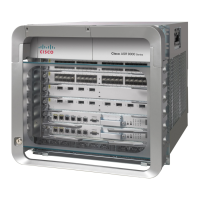116
Cisco ASR 9000 Series Aggregation Services Router Getting Started Guide
OL-28417-02
Introduction to the Cisco ASR 9000 Series Aggregation Services Router
Cisco ASR 9000 Series Router Overview
• Ignore Intermediate System-to-Intermediate System (IS-IS) Overload Bit Avoidance—This feature
allows network administrators to prevent a RSVP-TE Label Switched Path (LSP) from being
disabled when a router in that path has its Intermediate System-to-Intermediate System (IS-IS)
overload bit set. For more information on IS-IS overload bit aviodance, see the Cisco ASR 9000
Series Aggregation Services Router MPLS Configuration Guide.
• Label Switched Multicast (LSM) Point-to-Multipoint (P2MP) Traffic Engineering (TE)—LSM is a
solution framework providing multicast services over a customer's MPLS or GMPLS backbone
network. This feature uses the extensions to RSVP-TE to build P2MP trees. The data plane provides
support for the MPLS replications. For more information on LSM, see the Cisco ASR 9000 Series
Aggregation Services Router MPLS Configuration Guide.
• Soft-Preemption—Soft preemption is an extension to the RSVP-TE protocol to minimize or
eliminate the traffic disruption over the preempted Label Switched Paths(LSP). For more
information on how to achieve zero traffic loss, see the Cisco ASR 9000 Series Aggregation Services
Router MPLS Configuration Guide.
• Path-Option Attributes—The path option attributes are configurable through a template
configuration. This template, named attribute-set, is configured globally in the MPLS
traffic-engineering mode. For more information on how to implement path option attributes, see the
Cisco ASR 9000 Series Aggregation Services Router MPLS Configuration Guide.
For the complete list of New and Changed features, see the Cisco IOS XR Release Notes at:
http://www.cisco.com/en/US/products/ps5845/prod_release_notes_list.html.
High Availability
The router is intended for use in Service Provider and Enterprise networks that require high availability.
It is designed to provide high MTBF (Mean Time Between Failures) and low MTTR (Mean Time To
Resolve) rates. This minimizes outages and maximizes availability. The router achieves this using the
following:
• Component redundancy
–
Duplex power supplies
–
Cooling systems
• Fault detection
• Management features
• High availability features
–
Non-stop forwarding (NSF)—Cisco IOS XR Software supports forwarding without traffic loss
during a brief outage of the control plane through signaling and routing protocol
implementations for graceful restart extensions as standardized by the IETF. NSF requires
neighboring nodes to be NSF-aware.
–
Process restartability
–
Stateful switchovers
–
MPLS TE FRR
–
Bidirectional Forwarding Detection (BFD)
–
Standard IEEE 802.3ad link aggregation bundles

